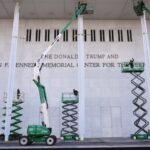

(The Center Square) – The rise of pro-Palestinian protests on U.S. university campuses often feature protesters calling for violence against Jews, leaving Jewish students feeling unsafe and frustrated by the lack of response from school administrators and federal officials.
Pro-Palestine sentiment is not new to many of these campuses, but the deadly Oct. 7 Hamas attack on Israeli civilians and the ensuing war in Gaza have sparked far more frequent and zealous demonstrations.
For Ethan Melman, a born-and-raised Chicagoan attending the University of Illinois Urbana-Champaign, that issue came to a head last fall when he, a Jewish student, attended one of the pro-Palestine protests to investigate.
Once there, Melman pulled out his phone to record, but he soon became the focus of the protest.
The video obtained by The Center Square shows the nature, speeches and chants from the protest, not dissimilar to others around the country.
“From the river to the sea Palestine will be free!”
“Educate those who think violence is unjust!”
“Decolonization looks like blood stained knives and searing bullets.”
One sign said “Keep the World Clean,” with a trash can donning the Jewish star of David.
Soon, Melman’s fellow students surrounded him when they realized he was recording and likely not on their side. He said he was struck by signs as well.
The experience left a mark on Melman, who said he only went because he knew other Jewish students would be too afraid to attend.
“Absolutely I don’t feel safe. There is nothing separating me aside from what I have on my own person at this point,” Melman told The Center Square, pointing out that many local and state officials in Illinois have made clear they support Palestine and that school officials have done little to address it, leaving him feeling unsupported and unprotected.
Melman said he was scared things could get worse, especially if the situation worsens overseas.
Pro-Palestinian protesters say they are standing up to oppression of the people in Gaza, who have been killed by the thousands since the Israel-Gaza war began.
“Visualize them breaking from these oppressive walls,” one protester said in a video of the incident. “Literally breaking down the barriers that have caged them for years. Finally consider the irony of labeling these people as terrorists and their colonizers as victims.”
“Resistance is justified when people are occupied,” another protester said.
A war several thousand miles away has come to the doorstep of many Americans, particularly Jewish students living on American campuses. But those protests in recent months have nearly always included calls and justifications for violence, even the Hamas violence on Oct. 7 against women, children and babies.
“Our fighting people, the only language the enemy understands is the language of revolutionary violence,” one protester said into a megaphone.
“Decolonization is a violent phenomenon,” said another.
Eann Tang, another student at the university who leads a conservative club on campus, attended the same protest and filmed Melman’s altercation with protesters. The video shows a tense protest, full of young people, Palestinian flags and signs as well as Melman’s intense standoff with the crowd.
After the incident, Tang sent a complaint to the Department of Education, which opened an inquiry. So far, though, Tang has not heard back more than the initial confirmation of receipt.
The Department of Education declined to comment to The Center Square, pointing to a news release from last fall.
Melman sent an email to his university’s president expressing the pain of the event and asking him to stop protestors from “terrorizing” Jews on campus.
The president responded, saying he heard Melman out and advised him to take advantage of the university’s resources.
Melman called the school’s response “underwhelming” and that it “goes to show how much ‘support’ he has for the issues I’m bringing up.”
Melman;s and Tang’s experiences are not unique, an increasingly normal feature of campus life in the U.S. where higher education institutions have become the center of the most divisive political issues, and as a result, political demonstrations.
In response to the rise of similar protests, Education Secretary Miguel Cardona released on open letter to U.S. educational institutions reminding them of their obligation under Title VI of the Civil Rights Act “to provide all students, including students who are or are perceived to be Jewish, Israeli, Muslim, Arab, or Palestinian, a school environment free from discrimination based on race, color, or national origin.”
The DOE has opened about 30 investigations into “shared ancestry” violations at schools and universities around the country since Jan. 1 alone, according to the agency’s website. There are about 70 new investigations since October of last year, though not all are necessarily about the Gaza issue.
The Anti-Defamation League released a survey last November reporting that 70% of Jewish students reported experiencing or witnessing antisemitism already that school year.
While the campuses and details of the protest change, the experience for Jewish students and the nature of the protests remain about the same.
“From Champaign to Urbana we support the Intifada!”







